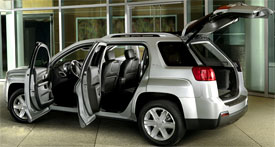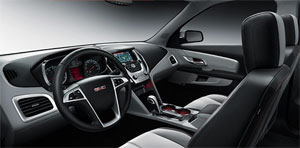2010 GMC Terrain
With sales of its surviving four brands doing well, General Motors appears on the road to recovery. A big reason is a steady stream of attractive new models. Case in point, the 2010 GMC Terrain. While sharing its mechanicals with the popular Chevrolet Equinox crossover utility, the Terrain shuns pure badge engineering, and dons the distinct, angled look of a more traditional SUV. Now, let’s see if it drives the same way.
While the 2010 GMC Terrain shares the Equinox’s compact-to-midsize Theta unitized chassis, it’s more “tough truck” shape ends up being about 2.5 inches shorter in overall length. So, to the eye, Terrain is stouter than the sleeker Equinox, and more along the lines of the venerable Jeep Cherokee.
The Terrain’s visual macho starts with projector-beam headlights, stacked to either side of a massive chrome GMC grille, which drops low into a deep, substantial-looking front fascia. The Terrain’s pronounced, squared-off fenders house wheels from 17 to 19 inches. Our tester split the difference, with six-spoke 18-inch alloys.
Standard roof rails proved useful, and fit the Terrain’s stance nicely. We also like the blacked-out D-pillars that give the impression of a wraparound rear greenhouse. Ditto the rear wiper that appears to float above a chrome bar connecting big, wide taillights. It shares no sheetmetal with the Equinox, but pop the Terrain’s hood, and things are happily familiar.
 Our all-wheel drive tester sported the same direct-injected Ecotec 2.4-liter four we applauded in the Equinox. Ratings are 182 horsepower and 172 pound-feet of torque. A 3.0-liter direct-injected V6 is optional with 264 horsepower and 222 pound-feet of torque, and when properly equipped, a trailer tow limit of 3,500 pounds.
Our all-wheel drive tester sported the same direct-injected Ecotec 2.4-liter four we applauded in the Equinox. Ratings are 182 horsepower and 172 pound-feet of torque. A 3.0-liter direct-injected V6 is optional with 264 horsepower and 222 pound-feet of torque, and when properly equipped, a trailer tow limit of 3,500 pounds.
In front or all-wheel drive, engines attached to a six-speed automatic with manual mode. Four-cylinders get an “Eco mode” which lowers shift points for better fuel economy.
This combo gives Terrain the same stellar fuel economy as Equinox. Our all-wheel drive four has Government Fuel Economy Ratings of 20 miles-per-gallon city and 29 highway. We managed an excellent 27.5 miles-per-gallon on regular gas. Our Terrain’s Energy Impact Score stands at a modest 14.9 barrels of oil consumed annually, and its Carbon Footprint of 8 tons of CO2 is likewise light-footed.
But, at the track, our Terrain loped from a standstill to 60 in 9.7 seconds. That’s about a second slower than the front-drive Equinox we tested last fall. Shifts came slow, even in manual mode. The quarter mile came in at 17.3 seconds at 83 miles-per-hour. Beyond times, however, the 2.4 felt plenty strong for highway passing, especially between five and seven thousand rpm.
The Terrain’s low power-to-weight ratio proved less of a hindrance through the slalom, where it felt much lighter than its almost two-ton curb weight. It delivered impressive car-style grip, sharp turn-ins, and only modest body roll, with none of the flabbiness of a traditional SUV.
Steering was slack on center, but tightened up nicely when we asked the Terrain to dance. In the high-speed lane change, the all-independent suspension and electronic control nannies kept the rear end reassuringly in check. Stomping the ABS disc brakes from 60 yielded a short average stopping distance of 122 feet. Brake feel was excellent: smooth and firm.
 All Terrain cabins come standard with flowing lines, soft-touch materials, and six airbags. They’re setup in a sporty, twin-cockpit theme that, except for the gauge pod, has a lot in common with Equinox.
All Terrain cabins come standard with flowing lines, soft-touch materials, and six airbags. They’re setup in a sporty, twin-cockpit theme that, except for the gauge pod, has a lot in common with Equinox.
Our well-optioned SLT included a sunroof, which shed light on the nicely drawn dash, and steering wheel audio controls that put channel surfing at our fingertips.
Bluetooth connectivity also fell easily to hand. Four auxiliary power outlets and a USB port are standard, as is Active Noise Cancellation. On 2.4 Terrains, it neutralizes engine boom using the audio system’s eight speakers. Also standard is a backup camera that shows up in the rear view mirror, or on the available navigation screen.
Our Terrain’s heated, leather trimmed front seats were plenty comfortable on long hauls. Equally comfy is the split-fold rear bench that, like Equinox, reclines and slides with eight inches of travel. Also like Equinox is Terrain’s optional programmable power liftgate. Besides full open, it can be set for a lower opening to avoid contact with a garage ceiling. Once open, owners find 31.6 cubic feet of cargo room seats up, and a small-for-its-class 63.9 cubic feet seats down.
Pricing, however, is very competitive given the Terrain’s high level of standard equipment. Base four-cylinder stickers range from $24,955 for the front drive SLE, to $29,945 for the all-wheel drive SLT. The V6 adds $1500 more.
For General Motors to prosper, they will need more efforts like the 2010 GMC Terrain. This gutsy, fuel-efficient, tough looking crossover is a family slam dunk, with build quality, interior, and drivability, on par with, if not better than, any rival utility across town, and across the oceans.
Specifications
- Engine: 2.4-Liter Four
- Horsepower: 182
- Torque: 172 Lb Feet
- 0-60 MPH: 9.7 Seconds
- 1/4 Mile: 17.3 Seconds @ 83 MPH
- 60-0 MPH: 122 Feet
- EPA: 20 MPG City/ 29 MPG Highway
- Mixed Loop: 27.5 MPG
- Energy Impact: 14.9 Barrels Oil/Yr
- CO2 Emissions: 8.0 Tons/Yr
2024 Polestar 2
More Range And More Power For The Polestar 2
Volvo is well on their way to making the transition to an all-electric brand, but their sister-brand Polestar is already there. Now, we’ve spent lots of time in their all-wheel drive, five-door Polestar 2, having tested it in 2021, and a year later when a two-wheel drive version arrived. But, EV updates are coming quickly. So, let us be your guide for all that’s new with the Polestar 2.
While we are driving more EVs than ever, we’ve also been spending a lot of time recently circling back to ones we’ve previously tested. As in this new era of electrified vehicles, significant updates are arriving quickly, with R&D investments increasing and retrofitting them easier than ever. This is often done through software updates that can even be accomplished over the air. For 2024, the Polestar 2 has indeed gotten some software updates, but some physical ones as well.
Clearly aimed directly at Tesla’s Model 3 when it arrived; the Polestar 2’s build quality was vastly better, but range definitely came up short. So, addressing that was priority No. 1; and for ’24 the Polestar can travel up to 20% farther than before while consuming 9% less energy, and when it comes time to charge it back up, it can do that 34% faster too.
Range in the Single Motor version increases from a max of 270 to 320 miles thanks to a larger 82-kWh battery pack, and that solitary motor now powers the rear wheels, not the front wheels. It’s also bigger, coming in at 220 kW compared to the previous 170 kW front-wheel drive version, going from 231 to 299 horsepower.
Dual Motors keep the same 78-kWh battery, but still sees a boost from 260 to 276 miles and takes advantage of the larger rear motor for a new combined 310-kW output with 421 horsepower. Our test car has the added Performance Pack, which uses an additional 35 kW to deliver 455 horsepower and 546 lb-ft of torque, though max range drops to just 247 miles.
The new battery in rear-drive 2s will also charge faster, now accepting up to 205 kW for an 80% charge in 20 minutes; max for dual-motors stays at 155 kW, which puts an 80% charge at 34 minutes. Using 32 kWh of electricity per 100 miles, the Dual Motor earns a good efficiency rating.
The [Polestar] 2 has always been one of the most enjoyable EVs to drive, even more so now with that additional power coming from the rear motor.
Unfortunately, extremely cold temperatures kept us from seeing that increased range, as we were only on pace for about 194 miles in our test.
The 2 has always been one of the most enjoyable EVs to drive, even more so now with that additional power coming from the rear motor. And especially when equipped with the Performance Pack as it not only includes more power, but adds 20-inch forged wheels, upgraded brakes, and adjustable Ohlins Dual Flow Valve performance dampers. It greatly improves handling prowess without affecting ride quality, and is easily worth the $5,500 charge if you at all enjoy driving.
Even on a 20-degree track day there was plenty of grip through our handling course. No understeer or oversteer, and lots of feedback through the wheel. There was a nice, strong launch off the line that properly planted us firmly in the seat, and rocketed us to 60 in 4.5 seconds. Power delivery stayed pretty intense up until about 80 mph when there was a definite tapering off. Still, it was a 13.4-second quarter-mile at 102 mph; smooth, quiet, and stable the whole way.
When this car debuted, its Google-based infotainment setup was a novelty, but since then, more and more manufacturers are just “Googling it” so it doesn’t seem out of place at all. The wireless phone charger is easy to access, and there’s a great Harmon/Kardon sound system and panoramic sunroof to enhance the in-cabin experience. Exteriors have also been enhanced with a smooth grille insert and new wheel choices.
Hatchback practicality means 14.3 cu-ft of easy to access cargo space with split-folding seatbacks for longer items and expanding the space to 38.7 cu-ft. Plus, there’s even a sizeable storage bin up front under the hood.
Single Motor Polestar 2 pricing now starts at $51,300, with Dual Motors starting at $56,700; topping out at $64,400.
For a car manufacturer that hasn’t even been around for a decade yet, Polestar has kept itself busy, totally transforming their latest model in just a few years, making the 2024 Polestar 2 even more appealing. They are certainly off to a good start, and with a host of Polestars just over the horizon, including some all-important utility vehicles, this star will be shining even brighter.
Specifications
As Tested
- Motor Setup: Dual Motor
- Horsepower: 455
- 0-60 mph: 4.5 seconds
- EPA Range: 247 miles
- Efficiency : 32 kWh / 100 miles
- Battery Size: 78-kWh
- Torque: 546 lb-ft
- 1/4 Mile: 13.4 seconds at 102 mph
- MW Test Loop: ~ 194 miles
- Peak Charging Rate: 155 kW











































